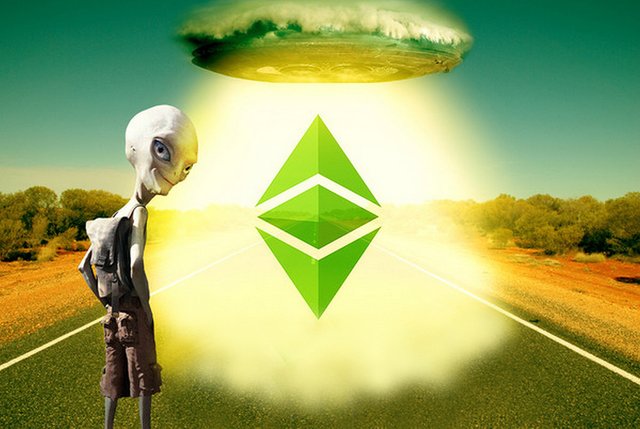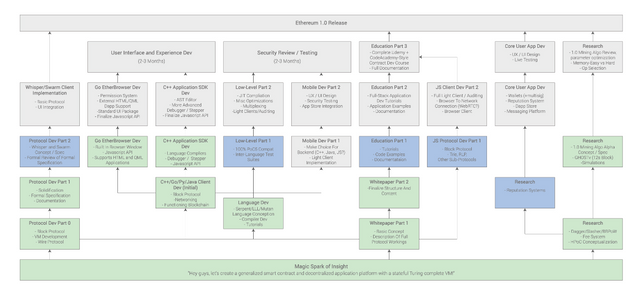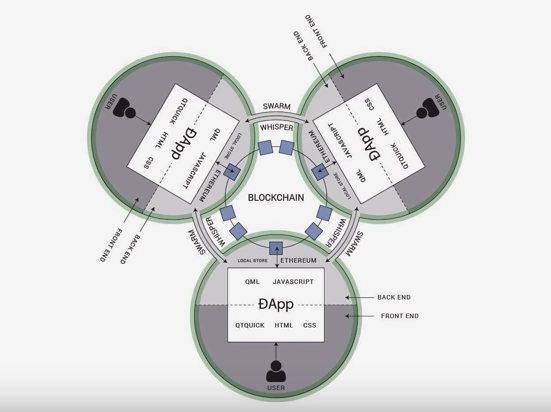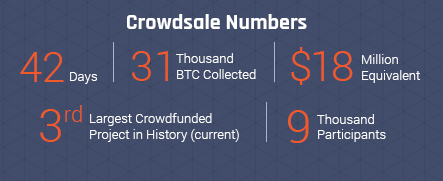Paul's wacky guide to Ethereum
History
Development began in 2013, by British programmer Dr. Gavin Woods. When a mutual friend introduced him to 19-year-old programmer and writer for Bitcoin magazine, Vitalik Buterin.
Ethereum launched on July 23, 2014, by founders Wood, Buterin, and help from many other bright-minded enthusiasts.
Buterin defined Ethereum first when he published the Nov. 2013 white paper titled "Next generation smart contract & Decentralized Applications (Dapps) platform" (original version - Nov. 2013)
In April 2014, Gavin Wood published the first formal specification of a blockchain protocol, the technical Yellow Paper titled "Ethereum: A Secure Decentralised Generalised Transaction Ledger" (original version - April 2014)
The Whitepaper and the Yellow paper were both revised from their original versions.
Gavin remained on the Ethereum Project as CTO 18-24 months after launch. He describes his involvement with Ethereum as:
"Having founded Ethereum with Vitalik, I coded the first functional implementation of Ethereum released as "PoC-1" in late January 2014, invented the Solidity contract language and wrote the Yellow Paper, the first formal specification of any blockchain protocol and one of the key ways Ethereum distinguishes itself from other blockchain-based systems. My original ideas for a decentralized web date back to early 2013, but my first post on the topic was in April 2014, later followed by a less-techy version." - http://gavwood.com/
Original Road Map July 23 2014
Ethereum Ecosystem
Every app runs on a node to stay operational, by combining thousands of nodes Ethereum aims to become a "world computer."
The "World Computer" of Decentralized Applications
A Dapp is a blockchain program built atop the Ethereum blockchain - it runs on a peer to peer network. The Ethereum network work how its founders imagine that the Internet should work. It's a world wide web of decentralized applications (Dapps) and smart contracts - sharing a common foundation - The Ethereum Blockchain.
Every Dapp runs in it's own virtual envirnoment; each built atop of the blockchain. Thus, thousands of Dapps connect and interact ecosystematically as the Ethereum "world computer."
Smart contracts
A term coined in 1994 by Nick Szabo, "smart contracts" are pre-written computer programs that can execute themselves automatically.
All parties agree to a set of pre-defined terms and execution conditions. Smart contracts trigger automatically when a party fulfills the pre-defined terms without relying on a central authority.
Implementing smart contracts via Ethereum adds to the efficiency of blockchain technology. Since its launch, most developers have chosen the Ethereum platform to code their smart contracts, compared to every other platform combined.
Ethereum Virtual Machine
The Ethereum Virtual Machine (EVM) is a Turing complete digital environment which allows users to code "smart contracts" that can execute themselves automatically from any computer.
The programming is all done inside a "command prompt like" digital environment called the EVM --- the Ethereum blockchain developers platform.
Ether
Ethereum uses "ether" (ETH) as its tradeable cryptocurrency; it is the fuel that sustains its grand ecosystem - a revolutionary concept to connect decentralized applications over a distributed network. Anyone can build and deploy Dapps that interact with users and smart contracts on the Ethereum blockchain. But first, you'll need to pay a cost in "Gas". Gas isn't a cryptocurrency, you cannot hold gas in a digital wallet. You buy gas for your smart contract by spending ETH. Everytime the smart contract executes itself, it exhausts some of that ETH.
ICO Platform
An Initial Coin Offering (ICO), is an "investment vehicle" for raising capital. Ethereum sparked a cataclysmic chain of events transforming the ICOs market from an online community of bitcoin miners, hackers, and developers --- to an interconnected global ecosystem of products and services. ICOs sell newly developed "tokens" which are coded using a smart contract.
Tokens
Tokens may represent a right to ownership of the project's assets or royalties. Sometimes, tokens purchased in an ICO represent a share of the controlin the company itself, which makes is much like an Initial Public Offering (IPO), except that an IPO is regulated and restricted, so it makes it difficult for an early stage company to raise enough money to fund its operations.
Some tokens are given one or more qualities that make them desirable for practical purposes other than a profitable investment. A utility token is designed for general support of the processes of a digital software or service. These cryptocurrencies are similar to real-world cases we see daily, such as gas reward points, in-store credits, and cash back rewards.
Ethereum ICO - July 23 2014 - Sept. 2 2014
Ethereums' founders self-sponsored an ICO event which opened to investors on July 23, 2014, and ended after 42-days of remarkable success on Sept. 2, 2014.
Over 7 million ether (ETH) sold during the first 12 hours. The equivalent value was over 3,700 BTC or $2.3 million. More than $18 million worth of Bitcoins. In return, over 60 million Ether tokens were distributed.
Now, Ethereum is a crowdfunding platform for anyone to sponsor create a token and sponsor their own ICO. It offers new startups in the cryptocurrency space a means of quicker and easier capital raise.
All-time ICO list of lists
- http://www.tokensalecalendar.com/
- https://www.smithandcrown.com/icos/
- https://www.reddit.com/r/icocrypto/
- http://icorating.com/
- https://icoo.io/
- http://www.icocountdown.com/
- http://www.coinschedule.com/
- https://tokenmarket.net/
- https://www.ico-list.com/
Ethereum Blockchain Technology
What does the Ethereum client software do?
● connect to the Ethereum network
● explore Ethereum's blockchain
● create new transactions and smart contracts
● Run smart contracts
● mine for new blocks
Use Cases
Satellite synchronization
During access verification, users and satellites can perform the mutual authentication through their public and private keys, and a user's authority is checked against his token. Meanwhile, the authentication logs are recorded in blocks which would merge and distributed between satellites merged and distributed between satellites.
Auto Insurance
A smart contract can record the policy, driving record and driver reports, allowing Internet of Things-equipped vehicles to execute claims shortly after an accident.
Supply Chain
Smart contracts can provide real-time visibility for every step in a supply chain. Internet of Things devices can record each step as a product moves from a factory floor to the store shelves.
Land Title Recording
Smart contracts that simplify property transfers can deter fraud, improve transaction transparency and efficiency, and strengthen confidence in identity.
Mortgages
The smart contract can automatically process payment and release liens from land records when the loan is paid.
Derivatives
Smart contracts can streamline post-trade processes, removing duplicate processes executed by each counterparty for verifying trades and conducting trade events.
In its beginning, the www.stateofthedapps.com was called www.EtherCast.com
The image below is a list of the first Dapps to exist on www.ethercast.com as of December 21, 2015
Ethereum Development milestones
Each stage brings new features to Ethereum and improves the user experience and security of the platform while boosting Ethereum's ability to scale.
The launch
Ethereum development is separated into 4 milestone phases to plan the future of the Ethereum blockchain architecture and to progress swiftly. You can locate the first roadmap in English here: Ethereum launch process. Here, we have outlined the development milestones for you.
Olympic pre-release (Testnet, Chain #0 - May 9, 2015)
Olympic rewarded people for testing the limits of the Ethereum blockchain during the pre-release period, spamming the network with transactions and doing crazy things with the state so the core developers could see how the network held up during high levels of load.
Phase 1: Frontier public release (Ethereum Genesis, Chain #1 - July 30, 2015)
Frontier was a beta release that allowed developers to learn experiment, and build Ethereum decentralized apps and tools. Frontier is the Ethereum network in its most minimalistic form. An interface in a command line for merging Ethers and for uploading and executing Ether Contracts. Miners constructed and run their mining rigs. With the Frontier release, people could test Dapps freely and buy Ether to upload their program in Ethereum.
Phase 2: Homestead Release (Block #1,150,000 - March 14, 2016)
Homestead was the second version release of the Ethereum platform. It included several protocol changes and a networking change that gave Ethereum the ability to further network upgrades.
The Homestead Phase began after Frontier was extensively tested and classified by the core developers as stable and safe. From the Homestead release, the first projects in Ethereum were developed and operating. These major forks took place during the Homestead phase:
- DAO Fork (Block #1,920,000 - July 20, 2016)
- DoS Fork (Block #2,463,000 - October 18, 2016)
- Spurious Dragon (Block #2,675,000 - November 22, 2016)
Phase 3: Metropolis Release (ongoing)
The Metropolis phase began when the official interface launched for technically inexperienced users. Similarly, Mist was provided in and its dapp store. Metropolis included functional programs created to testify to the power of the Ethereum network. Metropolis consists of two stages:
- Byzantium
- Constantinople
Phase 4: Serenity Release
Proof-of-Work (PoW) wastes tremendous amounts of energy; the Ethereum Network is to be moved to the energy efficient Proof-of-Stake (PoS) consensus algorithm. Additionally, the chain should be quicker and more accessible for beginners to understand and it's resilient against the interruption of mining capacity. The PoS system will be in fully implemented by the time Ethereum upgrades to Serenity.
In Constantinople,most of the transactions on the Ethereum network will use PoW. Every 100th transaction will use PoS. This will steadily lay the groundwork for Casper, the new PoS system used in the final phase of development - Serenity.
Why Proof of Stake?
Two motivations for the planned switch to Proof of Stake:
- Ethereum developers and researchers believe that a consensus algorithm, Proof of Stake (PoS) can provide more security for resource cost, compared to Proof of Work.
- Also, they believe that a new design called "Casper" will resolve the critical issues in Proof of Stake design including imperfect decentralization and vulnerability to certain types of attacks and other economic and performance considerations.
Casper
Mostly it's a mixed PoW, PoS algorithm which its purpose is to arrive one day to a full PoS implementation.
By using PoS consensus algorithms, you eliminate the mining concept. Then, developers think the block time can decrease till arriving at even 5 - 7s.
Sharding
Similar to Bitcoin Lightning Network, plasma adds a second layer of off-chain branches to the main Ethereum blockchain to process high volume smart contract protocols more quickly. In more advanced forms of sharding, cross-shard communication capability, where transactions on one shard can trigger events on other shards, is also included. You can see the benefits of this structure. The number of nodes that process every transaction would be reduced, and increase throughput.
Plasma: Scalable Autonomous Smart Contracts
Plasma is the proposed groundwork for enforced and incentive execution of smart contracts. Theoretically scalable up to a potential of billions of transactions per second, these smart contracts are incentivized to continue operation autonomously via network transaction fees, and reliant on the underlying blockchain to enforce transactional state transitions.
Ethereum Foundation is donating lots of $ to incentivize the research on sharding and plasma.
Other protocols built on Ethereum
What is Loom Network?
Built on Ethereum, Loom allows developers to run large-scale decentralized applications. It is a network of DPoS side chains, which provides for highly scalable games and user-facing DApps while still being backed by the security of Ethereum. Like how Filecoin tokenized disk space, Loom aims to be the tokenized application protocol of the new decentralized web.
DPoS = Delegated Proof of Stake
A layer-two blockchain that uses Ethereum as its base layer. Running each DApp on its side chain to Ethereum has several benefits. DAppChains use alternative consensus rule sets (like DPoS) that optimize for high scalability.
DAppChains: Each DApp On Its Sidechain allow for scalable blockchain games and DApps with the security of Ethereum mainnet. Like EOS on Ethereum.
PoA=Proof of Authority
PoA is an alternative consensus mechanism, which does not depend on the nodes solving arbitrarily tricky mathematical puzzles; instead, it uses a set of "authorities" - nodes explicitly allowed to create new blocks and secure the blockchain. Ethereum testnet (Kovan) runs on PoA consensus algorithm.
Third Party Software Services
Ethereum wallets
When you're searching the web for the best Ethereum wallet, look for these features:
- Security. Does it come with two-factor authentication? Are there processes are in place to allow for secure backup and recovery?
- Private keys. Look for a wallet that allows you to keep control of your private key, as this will allow you to protect your ETH holdings.
- Ongoing development. Research the customer support staff. Do they have negative reviews? What do they say? When was the last patch released?
- Ease of use. Cryptocurrency wallets can sometimes confuse a beginner, so look for a wallet with features that meet the needs of your experience.
- Compatibility. Can you store it on your flash or hard drive? Can you access your wallet on the devices you use to manage cryptocurrency?
- Support for many currencies. Will you need to store other crypto coins or tokens? Which ones? Does the wallet support them?
Paper Wallet
- Security, privacy, cheap cold storage
- Doesn't support Ethereum Classic, inconvenient
Hardware wallets
- High security, stores numerous crypto, quick setup and easy use
- High cost
- Security, ease of use, stores many coins and tokens
- High cost, long shipping delays
- Security, multi-currency support
- it's not cheap, relatively new company
- Simple and convenient access, retain your private key, interact with smart contracts
- Security risks
- Easy access, stores multiple Cryptocurrencies
- Private keys are not kept in your control, security risks in storing on an exchange
- Easy access to the Ethereum network and Dapps, user-friendly interface, private key protection
- Not as safe as hardware wallets can be a little confusing at first
Desktop Wallets
- Stores multiple cryptocurrencies, convenience, user-friendly, retaining control of private keys
- Some security concerns
- Stores multiple crypto assets, ease of use, retaining private keys
- No iOS app (yet)
Competition
On December 6, 2017, Amazon Web Services (AWS) announced a partnership with R3 to allow the company's "Corda" platform on the AWS. Corda enables users to deploy Dapps in the AWS platform. R3 is one of Ethereums direct competitors. Compared to R3, Ethereum generates $1M more revenue as reported by Owler.
Another development in close competition with Ethereum is The Linux Foundation introduced Hyperledger, Fabric, is the groundwork for developing applications with a modular architecture, The main difference between Ethereum and Fabric is in their consensus algorithms
Core Team
Ming Chan
Director, Council Member
An alumna of Massachusetts Institute of Technology, where she studied Computer Science and Media Arts & Sciences
Vitalik Buterin
Creator of Ethereum
He co-founded Bitcoin Magazine in September 2011, and after two and a half years looking at what the existing blockchain technology and applications offered, wrote the Ethereum white paper in November 2013.
Jeffrey Wilcke
Technical Steering Group
Jeff is one founder of Ethereum. He started the first implementation of Ethereum using the Go programming language in 2013 and has been the Go team lead and head developer ever since.
Market details
- ICO Round: Round 1
- Raised Capital: 18.4m USD
- Total Coins created at the sale: over 60 Million
- ICO Launch: July 23, 2014
- ICO finish: Sept 2 2014
- ICO Tradable on Exchanges since: July 2015
Max Supply:
Ether creation is capped at no over 18 million per year.
This means the relative inflation is decreased yearly.
Mining Rewards:
5 Ether is created after each block (~15 seconds)
2-3 ether is sometimes sent to another miner if they also found a solution, but it wasn't included.
Headquarters
- Ethereum London - London, GBR
- Ethereum Berlin - Berlin, DEU
- Ethereum Amsterdam - Amsterdam, NLD
Top 5 Exchanges
Decentralized Exchanges (Mostly Eth assets)
0x Relayers:
Recent News!
https://etherbasics.com/the-basics/phases-of-ethereum/
Ethereum co-founder Joseph Lubin said that the Ethereum blockchain had entered phase two of its development.
"Ethereum is moving into space where it can serve as the layer one trust system and built into Ethereum we'll have hundreds of thousands of transactions in the layer two systems, and we're going to see that ramified this year."






